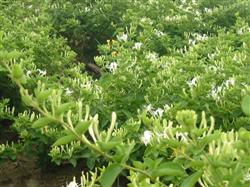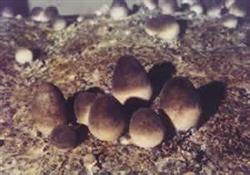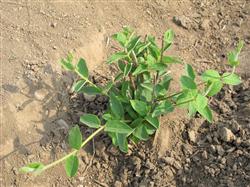Propagation and High-yield cultivation techniques of Flos Lonicerae

Honeysuckle (lonicera japonica thunb), alias honeysuckle, Erhua, honeysuckle or mandarin duck vine, is a semi-evergreen twining vine of Lonicera, with young branches densely covered with coarse hairs and glandular hairs, leaves opposite, ovate or ovate-lanceolate, 3-50n long, entire, coarsely hairy on both sides when young. Flowers born in pairs in leaf axils, Corolla tubular, 2-lipped, white at first, and then golden yellow. The berries are globose and black when ripe. The florescence is from April to June and the fruiting period is from October to November. Honeysuckle leaves evergreen winter does not wither, hence the name "honeysuckle", spring and summer flowers bloom, first white then yellow, yellow and white, and fragrant smell, is a good ornamental flowers and bonsai materials. Honeysuckle has strong adaptability and lax requirements on climate and soil; it is light-loving and shade-tolerant; it has deep roots, can withstand waterlogging, drought and cold, and can prevent soil erosion and strong sprouting; moist, fertile and thick loam soil grows best. 1 Propagation method (1) sowing seedlings were collected when the fruit was ripe in October, the pulp was washed off, the pure seeds were dried and stored in sand, and sown in April in spring. Soak the seeds with 25 tons of warm water for one day and night before sowing, mix them with wet sand, mix them indoors, stir once a day, sow seeds when 40% of the seeds germinate, then cover with grass, spray water once a day, and seedlings can emerge in 10 days. (2) Flos Lonicerae can be cut in spring, summer and autumn, but the survival rate is low in summer. The cuttings selected 1-2-year-old strong branches without diseases and insect pests, cut them into about-30cm, cut off the lower leaves, trenched according to row spacing 20on, ditched with a depth of 10-20cm, inserted obliquely in the ditch according to 2-3cm, left 10-15 cm in the aboveground part, filled soil, stepped flat, watered and moisturized, and rooting in half a month. (3) this method of strip propagation can be carried out in spring, summer and autumn. 3-4cm in the soil is pressed by vines to keep the soil moist, loosen the soil and weed in time, do not hurt new roots, and cut off and transplant the next spring after rooting. (2) cultivation and management (1) Flos Lonicerae can be selected for high-yield cultivation with gentle topography, deep, fertile and moist sandy loam. The acupoints were dug according to the row spacing of 100cm × l50cm, the diameter of the acupoint was 30cm, the depth of 30cm, and organic fertilizer 3-5kr was applied to each acupoint. Plant 5-6 seedlings per hole, or use 5-6 cuttings as fan-shaped cuttings. Water and seal the soil after planting. (2) after the cultivation of honeysuckle survived in the field, fertilization should be combined with loosening soil in early spring every year. The method is to open a shallow ditch at the 30cm around the flower pier, apply fertilizer ring into the ditch, then cover the soil, and form a basin-shaped soil around the flower pier to preserve fertilizer and water. For more than 5 years, 5kg soil miscellaneous fertilizer and 50-100g chemical fertilizer can be applied to the big flower pier, and less to the seedlings. Attention should be paid to watering to prevent drought in spring and flowering period. Before freezing, one frozen water can be irrigated and soil should be cultivated to prevent cold. In order to increase the yield of flowers, the twigs should be cut off every winter, so that the lower part is gradually sturdy, forming upright growth, and the growing branches form an umbrella shape, which is conducive to ventilation and light transmission, more flowering and convenient harvest. (3) the main pest control of honeysuckle is brown spot, when the disease occurs, the leaves appear yellow-brown spots, which mostly occur in July-August. Bordeaux solution or 65% zinc 0.2% solution can be used for prevention and control, and fallen leaves should be removed to reduce the source of the disease. The main pests are aphids, inchworm and longicorn beetles. Aphids and inchworms harm leaves and buds and can be sprayed with 0.125% solution of 90% trichlorfon. But the application of pesticide was stopped 20 days before flower picking. Longicorn beetles mainly harm xylem and cause stem and leaf death. The control method is to spray the ground with fish rattan essence or trichlorfon when longicorn beetles are unearthed before and after Ching Ming Festival, and cut off insect branches and inject medicine into wormhole when damage is found in summer and autumn. (3) when harvesting and processing honeysuckle, it is suitable to pick budding buds, and there are two harvest standards: one is that the upper part of the flower needle expands into white, the lower part is cyan, commonly known as "two white needles"; the other is completely white, commonly known as "big white needle". The "big white needle" should be collected in time, otherwise it will open on the same day, and the "second white needle" can be picked the next day. Harvesting too early or too late will affect the quality and yield of flowers. The flowers that have been harvested should be sun-dried or dried in time, stored temporarily, sun-dried and removed after regaining moisture, and stored in graded packaging. The harvesting of leaves and vines can be combined with pruning to cut some twigs in autumn and winter to dry human medicine.
- Prev

What about the deformity of Pleurotus ostreatus?
Ask for help: is there any way to make volvariella volvacea increase production? The planting network teaches you three methods to increase the yield of volvariella volvacea: the secondary inoculation is beneficial to the yield increase of volvariella volvacea. The mycelium of volvariella volvacea grows too fast and ages easily, which weakens its vitality and can not make effective use of the nutrients in the culture material.
- Next

Seedling raising and High-yield measures of Honeysuckle cuttings
The buds, flowers and leaves of honeysuckle can be used as medicine to clear away heat and reduce inflammation; rattan is used as medicine to treat rheumatic bone pain; flowers can extract aromatic oil and honeysuckle dew; it is also an ornamental tree species cultivated in landscaping and garden. First, honeysuckle cutting seedlings honeysuckle can be propagated with seeds, but also with cutting and root propagation.
Related
- Fuxing push coffee new agricultural production and marketing class: lack of small-scale processing plants
- Jujube rice field leisure farm deep ploughing Yilan for five years to create a space for organic food and play
- Nongyu Farm-A trial of organic papaya for brave women with advanced technology
- Four points for attention in the prevention and control of diseases and insect pests of edible fungi
- How to add nutrient solution to Edible Fungi
- Is there any good way to control edible fungus mites?
- Open Inoculation Technology of Edible Fungi
- Is there any clever way to use fertilizer for edible fungus in winter?
- What agents are used to kill the pathogens of edible fungi in the mushroom shed?
- Rapid drying of Edible Fungi

